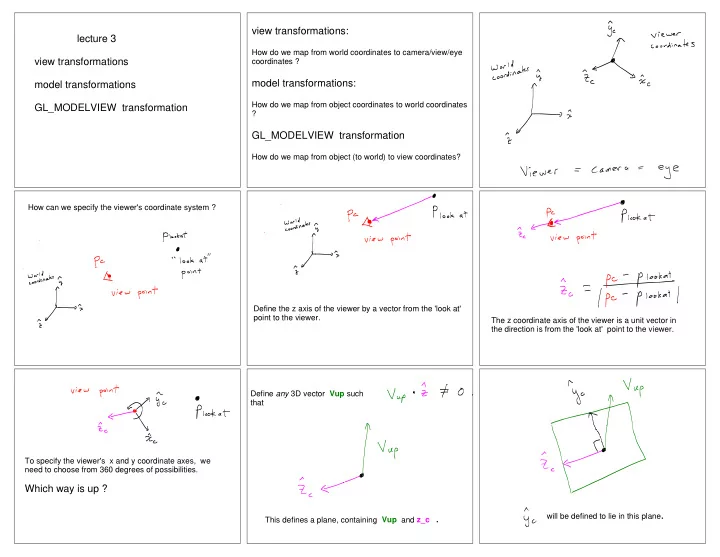

view transformations: lecture 3 How do we map from world coordinates to camera/view/eye view transformations coordinates ? model transformations: model transformations How do we map from object coordinates to world coordinates GL_MODELVIEW transformation ? GL_MODELVIEW transformation How do we map from object (to world) to view coordinates? How can we specify the viewer's coordinate system ? Define the z axis of the viewer by a vector from the 'look at' point to the viewer. The z coordinate axis of the viewer is a unit vector in the direction is from the 'look at' point to the viewer. Define any 3D vector Vup such that To specify the viewer's x and y coordinate axes, we need to choose from 360 degrees of possibilities. Which way is up ? will be defined to lie in this plane . This defines a plane, containing Vup and z_c .
As a programmer using OpenGL, you don't have to compute these vectors. Instead you just define: eye = ... // 3D points lookat = ... up = ... gluLookAt ( eye[0], eye[1], eye[2], lookat[0], lookat[1], lookat[2], up[0], up[1], up[2] ) What does this definition do ("under the hood") ? Coming soon... See lecture notes for the calculation. To re-map a general scene point (x,y,z) from world coordinates to viewer coordinates, we translate and rotate. What is the relationship between the world coordinate system and the viewer's coordinate system? R rotates into the viewer's Recall slide 7 from lecture 2. orientation. R maps to a new coordinate system by projecting onto new axes. Let the viewer's position be expressed in world coordinates. The matrix T translates the viewer's position to the origin.
view transformations: How do we map from world coordinates to camera/view/eye coordinates ? glVertex3f(x1, y1, z1) glVertex3f(x2, y2, z2) glVertex3f(x3, y3, z3) model transformations: How do we map from object coordinates to world coordinates ? GL_MODELVIEW transformation How do we map from object (to world) to view coordinates? glBegin( GL_POLYGON ) glBegin( GL_LINES ) glBegin( GL_TRIANGLES ) glVertex3f(x1, y1 , z1) glVertex3f(x1, y1 , z1) glVertex3f(x1, y1 , z1) glVertex3f(x2, y2 , z2) glVertex3f(x2, y2 , z2) glVertex3f(x2, y2 , z2) glVertex3f(x4, y4 , z4) glVertex3f(x3, y3, z3) glVertex3f(x3, y3, z3) glVertex3f(x3, y3 , z3) glVertex3f(x4, y4 , z4) // more vertex triples gives more triangles glEnd() glEnd() // more vertex pairs gives more lines glEnd() Quadric Surfaces: General "Quadric" (Quadratic) Surfaces: examples Recall homogeneous coordinates. Same quadric surface is represented if we scale 4D vector by a constant.
Q: What is this surface ? (a, b, c > 0) How to define quadric surfaces in OpenGL ? GLUquadricObj myQuadric = gluNewQuadric() gluSphere(myQuadric, ...) // need to supply parameters gluCylinder(myQuadric, ...) A: rotated and translated ellipsoid. Non-quadric surfaces from OpenGL Utility Toolkit Recall how to transform from world coordinates How to transform objects in OpenGL ? (GLUT) to viewer coordinates: glRotatef( vx, vy, vz, angle ) glTranslatef( x, y, z) glutSolidCube() glScalef( sx, sy, sz) glutWireCube() The parameters of each of these calls specify a 4x4 matrix. These transformations are not associated with (bound to) any particular object, however. glutSolidTorus() glutWireTorus() We'll see how this works next. glutSolidTeapot() glutWireTeapot() How to transform from dog (object) coordinates to viewer coordinates? gluLookAt( ... ) // transform from world coordinates // to viewer/eye coordinates glTranslate( ... ) // transform position and orientation gluLookAt( ... ) glTranslate( ... ) glRotate( ... ) // of dog to world coordinates glRotate( ... ) glVertex( ) // etc. all the triangles of the dog object ...... // defined in dog coordinate system
glMatrixMode(GL_MODELVIEW) glLoadIdentity() GL_MODELVIEW GL_MODELVIEW Q: What happens when initializes: Answer: you make these calls ? OpenGL is a "state machine". One of its states is the GL_MODELVIEW GL_MODELVIEW matrix. This is a 4x4 matrix that gluLookAt( ... ) transforms a vertex into eye coordinates. We would like : ASIDE: How to examine the GL_MODELVIEW matrix ? glRotatef( ... ) (python) m = (GLfloat * 16)() glTranslatef( ... ) glGetFloatv(GL_MODELVIEW_MATRIX,m) glModelViewMatrix = [ [ ] ,[ ], [ ], [ ] ] GL_MODELVIEW for i in range(16): glModelViewMatrix[i % 4].append(m[i]) # OpenGL stores in column major order print 'GL_MODELVIEW ', glModelViewMatrix glScalef( ... ) Problem: the GL_MODELVIEW matrix only keeps track Solution: use a stack of GL_MODELVIEW transformations. of one (model to view) transformation. But we may have hundreds of object models. glMatrixMode(GL_MODELVIEW) glLoadIdentity() How do we keep track of all these transformations? gluLookAt( eye ... , lookat..., up ...) glPushMatrix() glMatrixMode(GL_MODELVIEW) glLoadIdentity() glTranslate( ...) gluLookAt( eye ... , lookat..., up ...) glRotate(...) drawDog() glTranslate( ...) glPopMatrix() glRotate(...) drawDog() // glVertex() etc... glPushMatrix() glTranslate( ...) glTranslate( ...) glRotate(...) glRotate(...) drawHouse() // glVertex() etc... drawHouse() glPopMatrix() Summary of Today viewer coordinate systems view transformations : gluLookAt() model transformations : glRotate(), glTranslate(), glScale() GL_MODELVIEW transformation
Recommend
More recommend